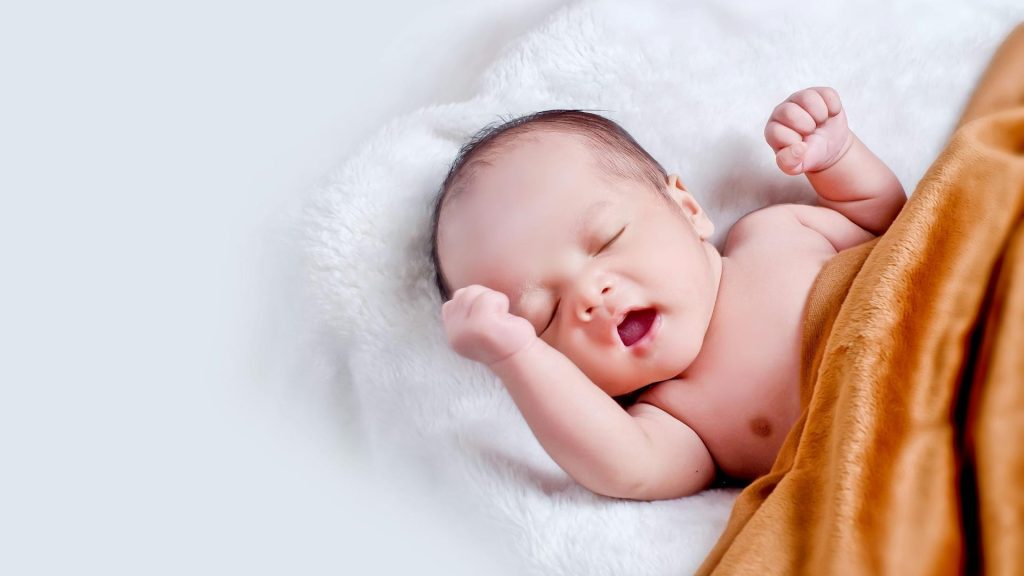FREE Shipping on Orders over $89 with Account – Create One Today!
- (844)-859-9400
- Get Help

Humidifiers are great for keeping babies comfortable and healthy by maintaining optimal humidity levels. They can help prevent dry skin and ease cold symptoms. However, there are also potential safety concerns like burns from hot steam or growth of mold.
Where do we draw the line between benefits and hazards?
Below, we’ll run through the must-know details on how to use humidifiers safely as well as looking at how close a humidifier should be to a baby.
When setting up a humidifier in your baby’s room, it’s vital to consider its placement for both effectiveness and safety. A general rule is to keep it at least 3 feet away from the crib, as indicated by the Children’s Hospital of Philadelphia. This distance allows mist dispersion without creating dampness on nearby surfaces.
Put the humidifier on a high surface like a dresser, so it’s out of reach of little hands. But make sure not to place it near any electrical outlets or cords as they pose potential hazards.
To maintain optimal humidity levels, position the humidifier close enough for effective moisture distribution but far enough not to create overly moist conditions that could lead to mold or bacteria growth.
A well-placed humidifier contributes significantly towards maintaining healthy air quality and providing comfort for your baby during dry seasons or when dealing with colds and allergies.
Humidifiers are often a go-to gadget in nurseries. But why?
Babies, especially newborns, have delicate skin and respiratory systems that need more moisture than adults do. A humidifier helps to maintain optimal humidity levels in your baby’s room, promoting their comfort and health.
The added moisture can soothe dry skin, help clear stuffy noses, and ease cold symptoms. Plus, it could give your little one an easier time breathing while they sleep.
A properly used humidifier is like having an invisible helper maintaining ideal conditions for your baby’s well-being.
Note: Be sure to consult medical specialists if you have any inquiries or worries regarding your child’s health. Humidifiers can help with the aforementioned symptoms, but they do not substitute for a personalized approach put together by a medical professional.
The use of humidifiers in a baby’s room can bring about certain safety concerns. The first is the risk of burns from hot steam. Many humidifiers work by heating water into steam, which could potentially burn a curious toddler who gets too close.
A second concern relates to mold and bacteria growth. A consistently damp environment is ideal for these organisms, leading to potential health issues like respiratory infections or allergies.
To minimize these risks, make sure you position your humidifier out of reach and clean it regularly using manufacturer guidelines. It’s also important to note that distilled water is preferred for use in a humidifier, as tap water can cause build-up leading to improper function of the device.
While there are legitimate safety considerations with using a humidifier in a nursery, they can be managed effectively with proper precautions and regular maintenance practices.
Deciding on the proper humidifier for your infant’s room can be like trying to make it through a never-ending maze. Don’t worry, we’ve got you covered.
Ultrasonic humidifiers, as their name suggests, use high-frequency sound vibrations to produce mist. They are known for being quiet and efficient – perfect if you want to avoid disturbing your little one’s sleep. Medical Monks offer several ultrasonic models worth considering.
If noise isn’t an issue and you’re looking more at cost-effectiveness, then evaporative humidifiers might be your go-to option. These work by blowing air over a wet wick filter – simple but effective.
In making this choice remember: It’s not about finding the ‘best’ model overall; it’s about what works best for your nursery environment and the comfort of your baby.
The safety and comfort of your baby is paramount, so it’s essential to use humidifiers correctly. Here are some tips:
Clean Regularly: Mold and bacteria love moisture. To prevent their growth, clean the humidifier regularly. It’s recommended to rinse out any leftover water every three days. You can deep clean with a vinegar solution (1 part white vinegar mixed with 1 part water) once per week.
Use Distilled Water: To prevent mineral build-up that might harm both machine longevity and air quality in your baby’s room, use distilled water instead of tap water which can sometimes have high mineral content.
Avoid Over-Humidification: To maintain healthy air quality, aim for 30-50% humidity levels. Use a hygrometer, an inexpensive device that measures indoor humidity.
Safeguard from Burns: If you’re using warm-mist models (they can help break up congestion), keep them out of reach as they heat water to steamy temperatures.
Remember that while using a humidifier can aid in providing optimal conditions for babies, it’s essential to ensure proper usage and maintenance. By following these tips, you can create a safe and comfortable environment for your little one.
Understanding how close a humidifier should be to your baby is essential. You’ve learned that while they’re beneficial for keeping babies comfortable and healthy, caution must be exercised.
The safety concerns shouldn’t scare you away but make you more aware. Awareness of potential risks like burns from hot steam or the growth of mold allows you to create a safer environment.
Determining the ideal placement is crucial – not too close, yet effective enough. Also, remember that safety tips like regular cleaning and monitoring humidity levels are non-negotiables.
In all things concerning your little one’s room, stay informed and proactive!

Edited for content by ADAM PAGE.
